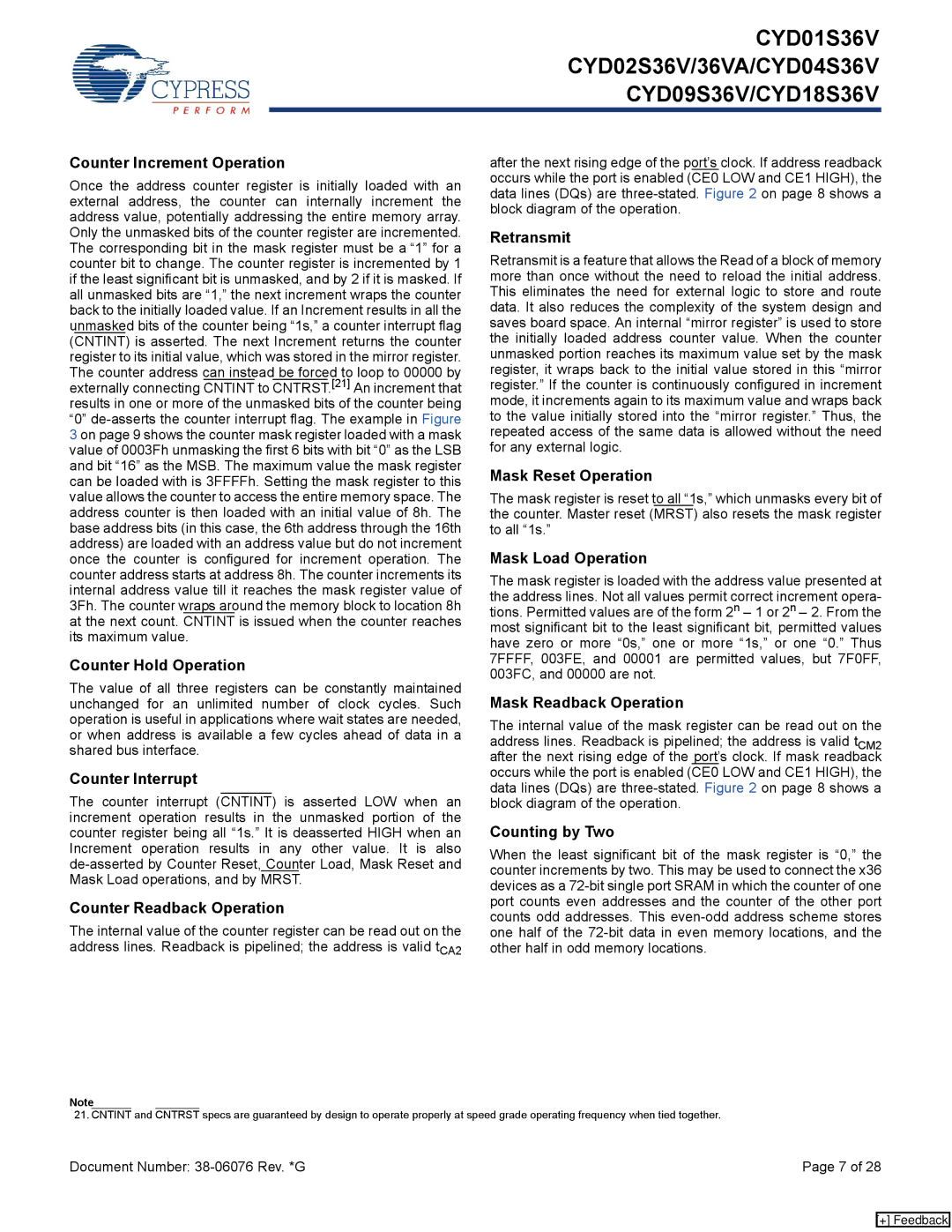
CYD01S36V
CYD02S36V/36VA/CYD04S36V
CYD09S36V/CYD18S36V
Counter Increment Operation
Once the address counter register is initially loaded with an external address, the counter can internally increment the address value, potentially addressing the entire memory array. Only the unmasked bits of the counter register are incremented. The corresponding bit in the mask register must be a “1” for a counter bit to change. The counter register is incremented by 1 if the least significant bit is unmasked, and by 2 if it is masked. If all unmasked bits are “1,” the next increment wraps the counter back to the initially loaded value. If an Increment results in all the unmasked bits of the counter being “1s,” a counter interrupt flag (CNTINT) is asserted. The next Increment returns the counter register to its initial value, which was stored in the mirror register. The counter address can instead be forced to loop to 00000 by externally connecting CNTINT to CNTRST.[21] An increment that results in one or more of the unmasked bits of the counter being “0”
Counter Hold Operation
The value of all three registers can be constantly maintained unchanged for an unlimited number of clock cycles. Such operation is useful in applications where wait states are needed, or when address is available a few cycles ahead of data in a shared bus interface.
Counter Interrupt
The counter interrupt (CNTINT) is asserted LOW when an increment operation results in the unmasked portion of the counter register being all “1s.” It is deasserted HIGH when an Increment operation results in any other value. It is also
Counter Readback Operation
The internal value of the counter register can be read out on the address lines. Readback is pipelined; the address is valid tCA2
after the next rising edge of the port’s clock. If address readback occurs while the port is enabled (CE0 LOW and CE1 HIGH), the data lines (DQs) are
Retransmit
Retransmit is a feature that allows the Read of a block of memory more than once without the need to reload the initial address. This eliminates the need for external logic to store and route data. It also reduces the complexity of the system design and saves board space. An internal “mirror register” is used to store the initially loaded address counter value. When the counter unmasked portion reaches its maximum value set by the mask register, it wraps back to the initial value stored in this “mirror register.” If the counter is continuously configured in increment mode, it increments again to its maximum value and wraps back to the value initially stored into the “mirror register.” Thus, the repeated access of the same data is allowed without the need for any external logic.
Mask Reset Operation
The mask register is reset to all “1s,” which unmasks every bit of the counter. Master reset (MRST) also resets the mask register to all “1s.”
Mask Load Operation
The mask register is loaded with the address value presented at the address lines. Not all values permit correct increment opera- tions. Permitted values are of the form 2n – 1 or 2n – 2. From the most significant bit to the least significant bit, permitted values have zero or more “0s,” one or more “1s,” or one “0.” Thus 7FFFF, 003FE, and 00001 are permitted values, but 7F0FF, 003FC, and 00000 are not.
Mask Readback Operation
The internal value of the mask register can be read out on the address lines. Readback is pipelined; the address is valid tCM2 after the next rising edge of the port’s clock. If mask readback occurs while the port is enabled (CE0 LOW and CE1 HIGH), the data lines (DQs) are
Counting by Two
When the least significant bit of the mask register is “0,” the counter increments by two. This may be used to connect the x36 devices as a
Note
21. CNTINT and CNTRST specs are guaranteed by design to operate properly at speed grade operating frequency when tied together.
Document Number: | Page 7 of 28 |
[+] Feedback
